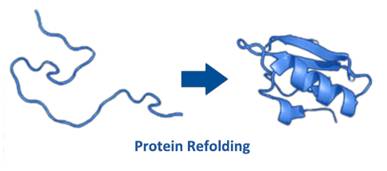 More than 50% of proteins expressed in E.Coli aggregate into insoluble inclusion bodies. Proteins form inclusion bodies are often expressed at high level. Refolding them into biologically active conformation is an attractive solution to obtain sufficient amount of samples at low cost Pepmic provide refolding service to restore target protein's native conformation. Our sophisticated approach includes applying DLS and other methods to guild refolding process. More than 50% of proteins expressed in E.Coli aggregate into insoluble inclusion bodies. Proteins form inclusion bodies are often expressed at high level. Refolding them into biologically active conformation is an attractive solution to obtain sufficient amount of samples at low cost Pepmic provide refolding service to restore target protein's native conformation. Our sophisticated approach includes applying DLS and other methods to guild refolding process.
Standard Protocol
Although there are some basic principles about protein refolding, the exact conditions for each protein can not be predicted. Solvent conditions including salts, pH, detergents and various of additives varies from protein to protein. Kinetic process including refolding pathway and refolding rate can also be critical. Exhausting all combinations is neither possible nor necessary. Explore even a small portion of the possible combination is a formidable task that will be costly. Over years, based on large number of samples we tested, we found a few factors that often play determining roles in refolding. Based on them, we developed a standard refolding protocol that offer a low cost solution to protein refolding.
For a refolding project, the target protein will first be tested according to our time tested standard protocol that includes three refolding conditions. About 65% proteins we tested so far have been successfully refolded under one of the conditions. The refolding is judged by protein solubility.
Custom Protocol
In cases that our standard refolding protocol fails, we provide customized protocol that includes screening up to 18 refolding conditions.
Successfully refolded samples (judged by solubility) will be sent to customer for functional analysis. Refolding will be scaled up based on results feedback from the customer. Alternatively, we can perform the functional assay on-site whenever it is feasible.
Refolding Analysis
Solubility is the most common method to determine refolding results. If a protein stays in solution, refolding is considered being success. This simple approach sometimes is quite effective. However, it is also often found that a refolded soluble protein is still biologically inactive. This can be (1) the protein forms soluble oligermer or (2) The protein is still in unfolding/misfolding conformation, but its concentration is too low to above its CMC.
If necessary, Pepmic will apply DLS (dynamic light scattering), size exclusive chromatograph and CD to analysis refolded protein. The results will be used to guide the further action to restore the native folding and biological function of the target protein.
Request a quote:
-
For protein refolding project, please email us for a quote: protein@pepmic.com
-
For protein expression and purification project contracted to us, we will send you a separate quote for refolding with the progress report if the protein is found to be insoluble in small scale test run.
|
